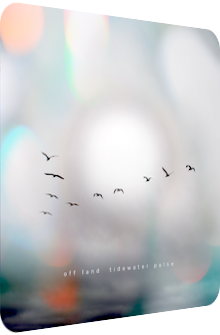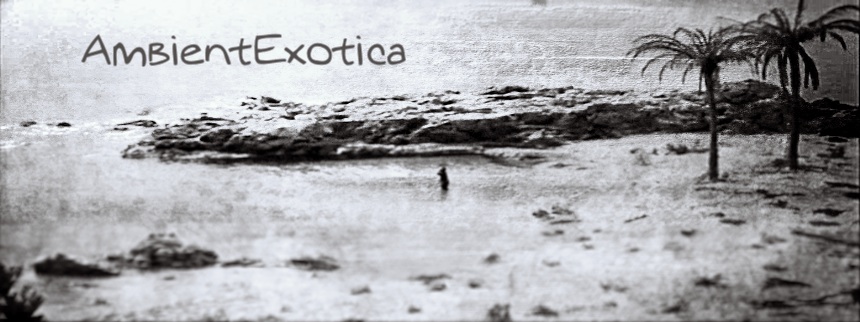
Off Land
Tidewater Pulse
2013
Tidewater Pulse is an aquatic ten-track album by the Boston-based artist Tim Dwyer aka Off Land which has been successfully backed via a Kickstarter campaign in January 2013. Released on Keith Downey’s Dublin, Ireland-based Psychonavigation Records in September and available to order and listen to in full at Bandcamp, the album features soft synth pads, field recordings and a surprising amount of real world instruments, but neglects the listener-related expectancy in two major ways, both of them resulting in a coup de main of an otherwise tame Ambient album. Firstly, Tim Dwyer’s background and previous releases suggest that Tidewater Pulse is a clear cut New Age album, with purified blotchy waters, ethereal surfaces and profound textures which altogether paint a better world that will never materialize in today’s times. This is only partially true. The album stays away from chintzy stereotypes, adds icy cascades and warm benignities that are usually not linked to the very genre that spawned in the late 70’s. Secondly, Off Land’s field recordings are rarely based on liquids, water and ocean waves, and once they are, a camouflaging process drapes the origin in a moiré-like veil, making Tidewater Pulse, its aspect of traveling as well as the depiction of different aggregate phases an oddly but staggeringly abstract one. This album could be about air, mountains or wraithlike realms. Only the liner notes and track titles tell a different story, but these give hints aplenty. The competition of water albums is ever-growing: Dreamfish’s eponymous work (1993) and its successor (1995), System 7’s Point 3: Water Album (1994), Thom Brennan’s Vibrant Water (2001) and Christian Doil’s Wasser (2010) are but five examples of a cavalcade of different approaches. How does Off Land’s Tidewater Pulse relate? And is the concept of water-related memories such as flights over the ocean or white water rafts perceptible or astute without glaringly obvious water sounds?
The opener Before sits near the apex or meeting point of different style lines that are utterly compatible with each other, but still different enough to not form an archetypical synergy, especially not in this Drone-heavy decade. This prelude to every intrinsic element of the album is based on a short-lived organic field recording of branches and birds which oscillates rhythmically, rotatorily and repetitively through the organ-fueled benignancy and New Age-oid tendency of self-imposed isolation for contemplation purposes. It is no real New Age artifact, for it lacks the ethereal freshness, but the tone sequences protrude thermal warmth and erudite euphony and are therefore close enough. With field recordings and a bow before the 70’s, Before depicts a calm sea. The water cycle starts gently. The follow-up Precipitation is much less earthen than cherubic. It may seamlessly connect to Before by sporting the same amicability and droning aorta, but soon enough introduces aqueous piano prongs whose reverberated afterglow coalesces with hollow chants in the distance. Without a beat structure or the implication of a revved up tempo, the structure feels livelier and aquiver with pleasant anticipation, thus poignantly referring to the track title. In addition, Precipitation feels more translucent and illumined, almost whitewashed.
Up next is the long-form piece Drift Ice, and even though its title implies the stillstand of the water cycle, nothing could be farther from the truth. I do not even need to frantically search for good reasons to back my cognition: the opaque yet cautiously diffused 4/4 beat structure towers above the ice like a cascading monolith and moves ever-forward. The falsetto/staccato of the adjacent ice crystals augments the feeling of moving patterns further, but even when the straight beat eventually vanishes and the crystalline ice structure legatofies into a thick glaze of hibernal ice, the omnipresence of vaulted crackles and breaking frizzles imposes the impression of time wafting through the interstitial clefts. During the last third, the ecclesiastic timbre makes a return, ostracizing the glacial mood and returning to Mediterranean climes. While the next composition Never Been is glaringly dualistic and meshes the sylvan brass tendrils of Gas’ Königsforst (1999) in the shape of a two-note horn melody with spheroidal-vitreous dulcimer crystals, chirping birds and ocean waves, which according to Tim Dwyer hail from South Carolina, Wait is either a huge letdown or the much-needed counterpart to the welcome forsakenness, as it moves to shores – or rather: waiting halls at airports or train stations – crowded with humans and their bustling chitchat; that Wait later mutes the scenery and begins to sport liquedous and spheroidal droplets as well as synth serpentines makes for an odd balance or a complete lack thereof.
Pictures follows and is the only clear cut New Age track on the album, inheriting and emanating every welcome formulaic main ingredient of the genre: pristine and purified synth washes of the glistening kind, that wraithlike-elysian interim state which enchants as much with its ecclesiastic solemnity as it makes the listener aware of his or her earthbound state, short bursts of field recordings and cosmic vesicles as well as jingle-worthy prongs. Pictures offers supreme contemplation. In what could almost be an opaque sub-theme for the album, it is yet another winter-related track which decidedly breaks its potentially sorrowfully frozen lapse by featuring an encore of the 4/4 beats. Silkened shakers, a polyphonic loftiness and slightly incongruent synth movements create a mélange of floating water rather than bays filled with thick ice. This impression does not appear out of the blue but is interpolated via Off Land’s music itself where icy and mild fluxions float in unison. My favorite composition, however, is Petrichor, a fascinating piece of soothingness, supercharged with pentatonic protrusions, abyssal bass prongs and an iridescent drone-based effulgence. Uniting all native elements as well as different styles, Petrichor marries Glitch freckles with aeriform Drone rivers, field recording goodness and – you’ve guessed it – New-Age flecks. The calm of the cavity, the echoey reverberation, the strong but not overly harmonious overtones create a wondrously reduced vivacity which the finale Storm Passes cannot possibly reach, but may at least partially capture thanks to its simultaneity of blurry fog banks and flute-like incisions of clarity. Neglecting the track title completely, the last tune fathoms out the retrogressive charm of fir-green synth choirs, moments of quasi-silence and enigmatic tone sequences. In my opinion, the storm does not pass. It passes on passing.
Considering that it is a water-glorifying concept album, Tidewater Pulse is based on a surprisingly – and fruitfully – different approach. Tim Dwyer’s endeavor is not to encapsulate the listener in shelter-giving machines à la submarines that float underwater. Neither does he take the subject to beach panoramas charged with gently floating waves, nor completely frozen seas of gelid gales. The album transmutes all of these scenarios, and while there are many interspersed field recordings, the only transparent markers are bird-related or sport human voices; everything else is camouflaged. Whatever the original field recording may have been, it meshes so overly well with the synth-fueled soils, airflows and flumes that there is no room for famous and overused clichés such as waves, drops, dripstone caves, fountains, faucets et cetera. With this welcome abstraction comes the loss of transparency: there are moments in which the element is completely hidden and indecipherable to the listener, lest he or she reads the liner notes. What is common in Celer’s albums whose music is always beautiful but places the driving factor in the explanatory notes outside the music-related peripheries, is also applicable here on Off Land’s Tidewater Pulse. It takes guts to not only mask the moisture but to also hide the large arsenal of real-world instruments. Tim Dwyer has sent me an email in which he explicates his endeavor on the basis of the track Never Been as an example. Sure, the horns are a prominent part, but the kalimba and ocean waves are only noticeable by the connoisseur. Again, this is no weakness, let alone the result of a wrong approach, but simply a skillful transfiguration. I much prefer the colder infusions such as Drift Ice, Permafrost and Petrichor, but even the warmer pieces enchant with their positively solemn attributes. New Age fans, synth lovers and Drone aficionados alike shall investigate, just don’t expect the gallons of liquids that are spilled in other water albums.
Further listening and reading:
- You can purchase and fully stream Tidewater Pulse at Bandcamp.
- The Twitter handle of Off Land/Tim Dwyer is @OffLandMusic.
Ambient Review 265: Off Land – Tidewater Pulse (2013). Originally published on Sep. 25, 2013 at AmbientExotica.com.
